Our Ultimate Guide to Referral Program Optimization
Referral program optimization is an essential part of any successful referral marketing strategy. The benefits of optimization include increasing program engagement as well as increasing conversions from referred customers. Brands must be concise and to the point with their messaging across all of their referral marketing touchpoints like in-app pages, social invites and referred customer onboarding.
This guide will highlight how brands are optimizing their referral invites and CTAs to get better results from their programs. Using examples from leading consumer brands, we’ll explore how to improve the effects of multi-channel referral messaging, word by word. After reading, you’ll be ready to deliver more value through your referral campaigns.
Best Practices for Referral Program Optimization
Like all optimization campaigns, the secret to being successful is strong copywriting. The twist comes from the need to provide relevancy in a different way, mentioning that users have received a referral from a friend. Easy enough to do.
#1 Use Actionable Language
Being instructive and active with subject line copy is important because it drives readers to engage with the message. Active verbs (like “download,” “watch,” learn,” “buy,” etc.) tell the reader what to expect from email copy as well as promoting the action itself. For example, “Help your closest friend take a much-needed vacation” both suggests the idea of doing something nice, while inviting further reading.
Top-of-mind language provides benefits while steering user thinking. Make sure that clarity is a top priority as well. A straightforward subject line that lacks imagination is preferable to one that confuses a reader and is overlooked.
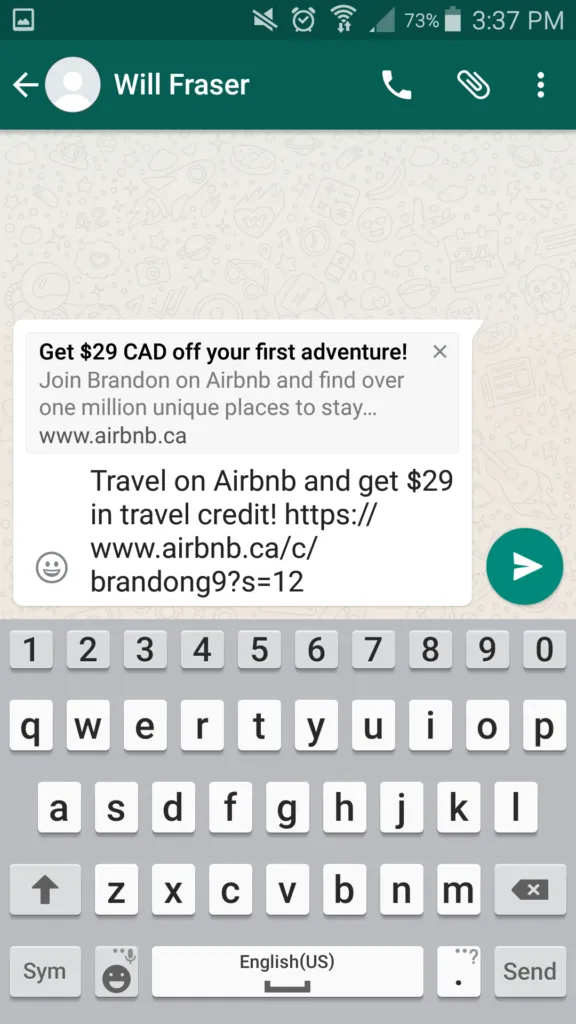
This Airbnb mobile message informs us to “Get $29 CAD off.” Anyone feeling the urge to seek adventure and get away from the grind will immediately connect with the allure of discounted travel and savings referred to them by their friend.
#2 Personalize and Invoke Friendships
Humans are wired to respond to our own names. Crafting headlines that include personal information can increase opens significantly – more than 22% according to research from Adestra.
For referral programs, invoking the name of a friend in the subject line can be incredibly helpful. For example, “Your friend Bob wants you to both enjoy this special offer” draws the reader in by referencing a mutual acquaintance. People trust their friends and gravitate to their names. This technique has the added benefit of leading directly into your messaging copy.
Direct Marketing Association research found that segmented and targeted emails generate 58% of all revenue in those surveyed. What’s more, 36% of these revenues were driven by emails sent to specific target choices. This tells us that anytime you can use personally relevant information in a headline your viewer will appreciate it.
#3 Ask Questions
Asking questions in email subject lines is effective for a handful of reasons:
- It sparks immediate curiosity
- It addresses readers with a “you” and involves them on a personal level
- It’s short and direct (hopefully)
- It caters to their self-interest
Even empty subject lines ignite reader curiosity. Sidekick found that emails without any subject line saw an 8% higher open rate than those with a subject line.
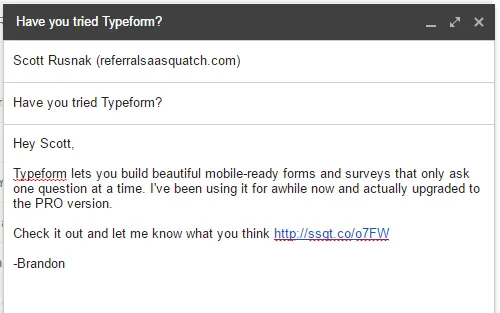
This email appeals to reader’s inquisitive nature, begging the question and inviting them to uncover what Typeform is all about. Showing is always better than telling with copy and the power of suggestion is even stronger.
The message is brief and personalized, summarizing to Scott the benefits (not features) of the product. A sincere testimonial recommends the upgraded version before the message ends with a brief CTA.
#4 Keep Subject Lines Short
The good researchers at Retention Science confirm that short and sweet is the way to write subject lines. They found the range that received the most opens is between 6-10 words, with less being better than more. Keep in mind that anything longer than 50 characters is going to get cut off.
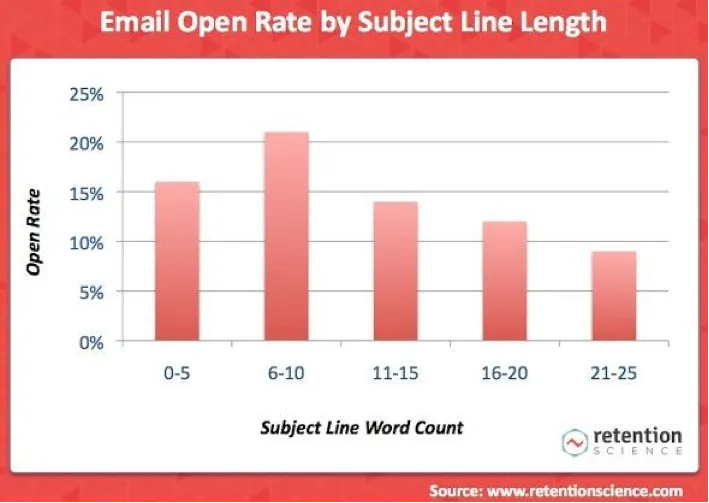
People see a lot of emails, so keeping text to a minimum allows for easy scanning and engagement.
Remember to write for mobile devices as well. 53% of emails are opened on mobile first, says Litmus. The average mobile screen can fit 4-7 words in the subject line at max. If your subject lines are cut off your messaging appears to ramble, which isn’t great for your brand image.
How to Write Referral Copy That Converts
Referral copy and referral subject lines must be aligned to get best results. When readers click on your message, they expect what’s promised to be delivered – and in short order. A high email or message open rate requires the support of clickthroughs and conversions to achieve referrals.
The same principles that go for email and subject lines go double for social message copy. With less room to work with, marketers need to stay on top of punchy and value-laden text to drive action.
Again, email and social share referral messaging hinges upon reminding users about reciprocal benefits while maintaining good practices of copywriting in a shorter area.
Let’s see how to write best within these constraints.
#1 Use Personal Language
Use the pronouns like“you,” “your,” and “yours.” For example, “Don’t miss your opportunity to save on your next purchase” directly involves the reader and orients the conversation around them. This makes them feel unique and included instead of just one in a throng of email subscribers.
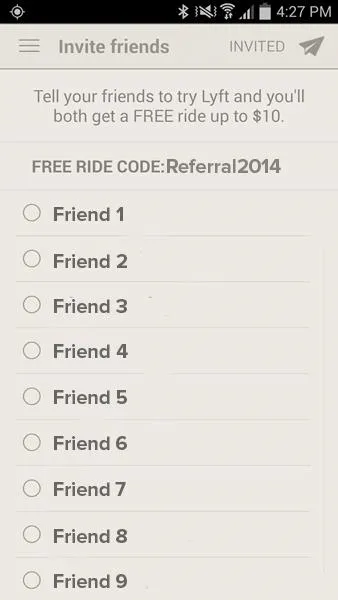
This Lyft message makes double use of “your” and “you’ll” to stay focused on the benefits for readers and their friends. The complementary offer is bolded to stand out against the rest of the copy and the referral code is prominently displayed for immediate use. All that’s left to do is invite friends with those easy-to-use CTA buttons.
#2 Write in a Conversational and Branded Tone
Messaging is all about delivering information. But that doesn’t mean you need to sound robotic or uninteresting. Copy that reads like a brief exchange between acquaintances helps put readers at ease and reminds them that they’re interacting with their trusted brand and ally.
Informal language like “Howdy” or “Hey there” adds personality and humanizes the exchange, increasing the likelihood of responses. Users enjoy fun messaging with a little flair; just be sure the word choice and tone align with your brand. Boom!
#3 Be Brief and Deliver Benefits
Emails and messages are not stories, they’re permission-based snippets of information that give you an opportunity to share relevant information. Snappy and direct copy converts better in referral programs, as people are busy and don’t allot much time to reading their emails and messages. Instead, users are scanning for benefits.
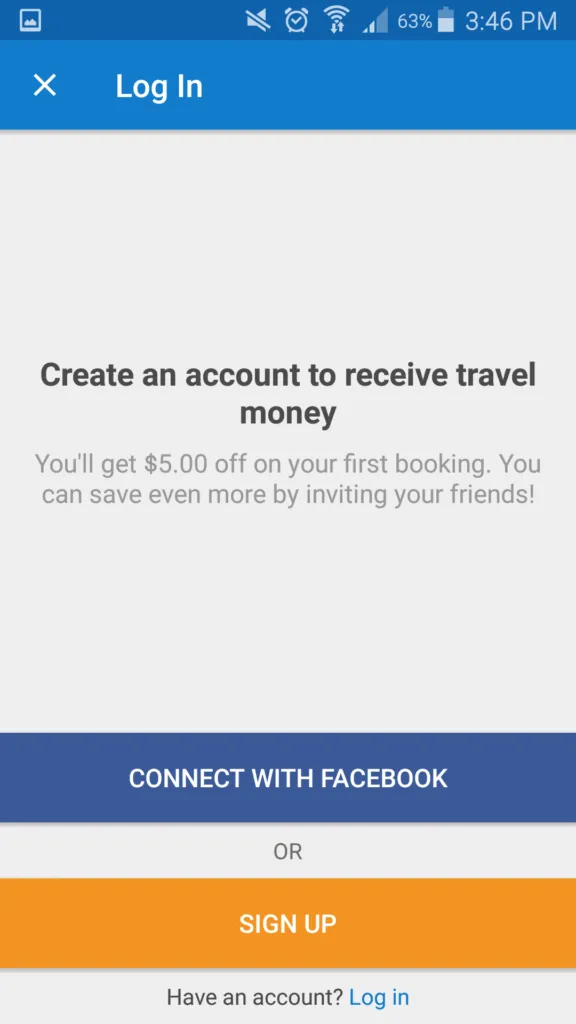
This Busbud message is so simple yet so actionable. After a bolded and actionable statement of benefits, readers have three actions: “connect,” “sign up,” or “login.” The recipient gets instant value and can take direct action with the CTA buttons.
#4 Make Your Message Relevant
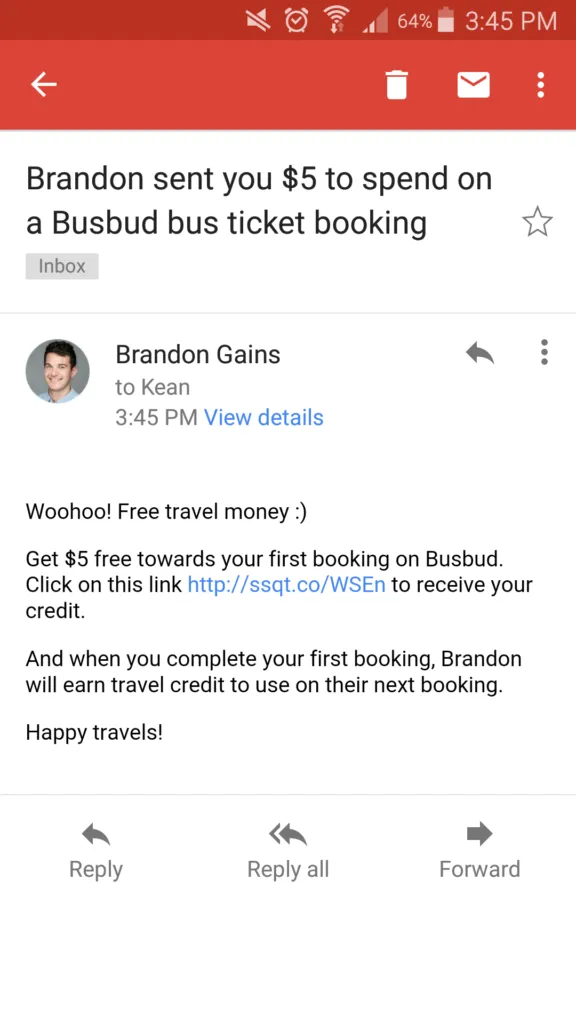
This mobile optimized email is perfectly crafted. Starting off with the subject line “Brandon sent you,” the reader immediately knows this message is specific to them and involves a friend so is worth reading. The rest of the subject line copy is direct and packed with benefit.
The message copy itself uses a friendly tone with power words like “free” to provide instant gratification to readers.
The call-to-action (CTA) is prominently placed for easy conversions. Plus, the link is trimmed down so not to distract from the overall message. Creating custom URL tags can be crucial when working with limited email and messaging space.
The personalized thumbnail also connects with users who are looking to do good things for their friends and themselves. The message ends succinctly with an altruistic reminder that your pal Brandon is going to get a boost from your signup. Happy travels and good vibes all around!
#5 Pay Attention to Your CTAs
It’s a shame to invest time writing captivating subject lines and copy only to boggle the call-to-action (CTA). Conversions are driven by actionable language:
- CTA links smartly embedded in emails
- CTA buttons in social messaging
Guide your readers to desired results with the power of your words.
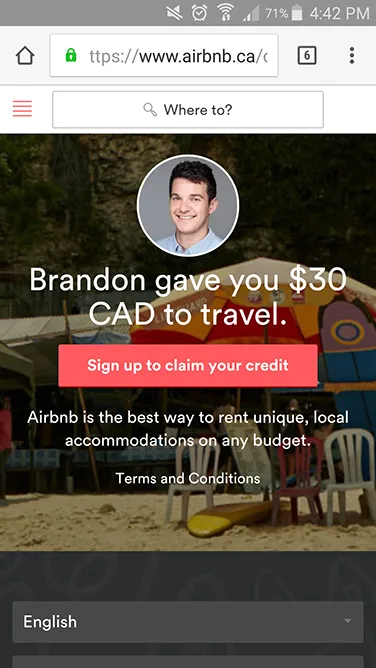
Airbnb knows that share messaging relies upon bold and well-designed CTAs. The dual-action language guides the user to “Sign up” and “claim your credit” for double whammy conversion.
For emails, Hubspot found that people prefer plain text without images. Simply embed your link amidst concise and active email copy. If links start to look like long blue snakes on the page, they’ll squeeze the life out of fine-tuned copy and cut into valuable space. Tighten them up with a URL shortener to breathe life back into the words and keep readers focused.
How to Write Copy for Friend Onboarding Landing Pages
Your referral program is producing results with great subject lines and body copy. Now it’s time to take it to the next level with a referral optimized landing page for new visitors.
Friends of friends will arrive on your referrer landing page after clicking on your referral CTA. Whether they arrive from your site, an email, or social media, this is an ideal moment to prompt action like sharing a link, emailing friends – or becoming a customer. Once they’ve committed to your brand somewhat with a link-to, the positive energy is there and it’s smart to use this momentum.
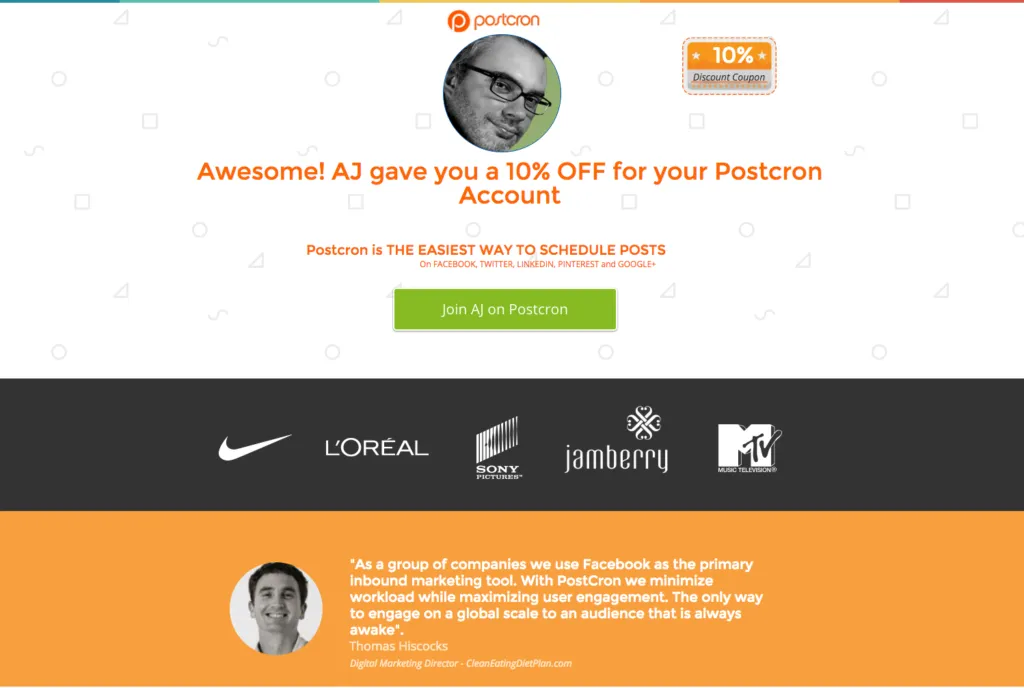
We recognize that Postcron is using all the great copy techniques we’ve discussed to convert potential advocates. The brand makes use of informal yet exciting copy to tell the visitor that his friend uses Postcron and wants him to join at a discounted rate. A bright CTA awaits.
The site also makes great use of social proof, employing both a thumbnailed testimonial (people love to see pictures of other people) and brand association through a strong showing of the prominent companies also using Postcron.
Inspiring a potential customer to join you at a friend’s request is a matter of creating immediate value, and landing pages are a great way to greet newcomers with an exciting offer.
Your Key Takeaways
This has been the guide to optimizing your referral programs with copywriting best practices. Keep in mind that your brand directly benefits from improving the power of subject lines with personalization and direct, active language.
When crafting body copy for emails and social share messages, keeping things brief and value-forward is key. Always stay relevant by reminding users that their friends have referred them, and reinforce the benefits of such an association.
Making sure your CTAs are actionable and concise is crucial, as is being friendly and direct with potential advocates. Whether you’re optimizing referral page CTAs, referrer invites or referred friend onboarding, your tactics need to be consistent and provide value to your customers.